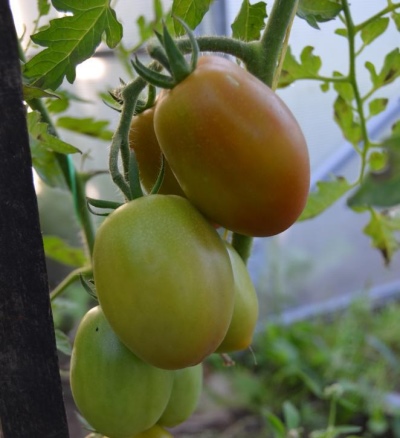
- Authors: Gavrish S.F., Morev V.V., Amcheslavskaya E.V., Degovtsova T.V., Volok O.A.
- Year of approval: 2015
- Category: grade
- Growth type: indeterminate
- Appointment: fresh consumption
- Ripening period: mid-season
- Ripening time, days: 115-120
- Growing conditions: for film greenhouses
- Bush size: tall
- Bush height, cm: up to 200
Tomato Sicilian pepper belongs to one of the mid-season tomato varieties. The main feature of the tomato is its rapid growth, due to which it requires special attention from the gardener. It is also worth noting its high yield, which is the reason for its popularity.
Description of the variety
The variety is a large plant that can grow to a great height, up to two meters. Sicilian peppers thrive both outdoors and indoors. Due to the constant growth, the bush needs a mandatory garter to a stable support.
The main qualities of the fruit
Tomatoes from the bush grow in small clusters, each of which has an average of four tomatoes. The fruits resemble peppers in appearance, which is why the variety got its name. The weight of each tomato reaches 200-250 grams. When ripe, they are distinguished by a bright red color.
Taste characteristics
Sicilian peppers are distinguished by their juicy and pleasant taste with fleshy pulp. Tomatoes can be eaten in their natural form, as well as canned and set aside for future freezing. Ripe fruits are best eaten as soon as possible, and the green ones are left to ripen. Even cracked and crushed tomatoes can be used in juices or sauces.
Ripening and fruiting
Like other mid-season tomato varieties, the first fruits of Sicilian peppers, on average, appear only after 115-120 days. At least four tomatoes ripen from each cluster of plants at the same time. The very same fruiting begins in the period from July to August.
Yield
Sicilian pepper is one of the highest yielding tomato varieties. So, each plant is able to bring up to 5 kilograms of tomatoes for the entire season. In order for the bush to bear even more fruits, it is necessary to carefully and carefully look after the plant. The bush achieves best results when it forms into one stem. Before that, you need to remove the stepsons.
The timing of planting seedlings and planting in the ground
Seeds should be planted for seedlings closer to mid-March. Before that, you should prepare special containers with moistened soil, where the seeds should be laid. In order for the seedlings to be uniform, the seeds must be treated with an aqueous solution of potassium permanganate.
Planting a bush in open ground or under a film shelter should occur 60 days after the preparation of containers. It is important to remember that the plant must be hardened before seedling so that it gets used to the local temperature. This is done as follows: 7-10 days, seedlings need to be taken out into the street for 20 minutes, every day the time increases up to 2 hours.

Growing tomato seedlings is an extremely important process, because it largely depends on whether the gardener will be able to harvest at all. All aspects must be taken into account, from seedbed preparation to planting in the ground.
Landing scheme
Landing on the garden should be done according to the scheme 40 by 50 centimeters in small pits.A few leaves should remain above the soil itself. Gradually, the plant will get used to the local soil, grow overgrown with roots and soon begin to feed itself with all the necessary substances.

Growing and care
After the seeds have been sown and treated with a solution of potassium permanganate, the container is covered with a film, which is removed only after the seedlings begin to hatch. During this period, the seedlings must be kept in an air temperature of + 22 ° C or + 23 ° C. The plant must be regularly watered with warm water, as well as timely fertilizing with complex fertilizers, so that the plant becomes stronger and stronger. The pick is carried out at the stage of the formation of the first leaf.
It is also worth noting that the seedlings have a great need for a warm temperature. In cold weather, the yield becomes much smaller, and the bush itself weakens. To prevent this, the tomato must grow in regions with a warm climate or in greenhouse conditions.
Do not forget that the plant also needs light. For this, it is recommended to use artificial fluorescent lighting if cloudy weather is expected all day.
The bush is able to grow to a great height, and therefore it needs a garter. Otherwise, it can grow into a real jungle, which will make the tomato yield much less. It is not necessary to wait until fully ripe to harvest the fruits, since both green and red tomatoes are juicy and delicious when preserved. And also green fruits can ripen later on the windowsill.




A plant needs different micronutrients at each stage of growth. All fertilizers can be divided into two groups: mineral and organic. Folk remedies are often used: iodine, yeast, bird droppings, eggshells.
It is important to observe the rate and period of feeding. This also applies to folk remedies and organic fertilizers.
Disease and pest resistance
The variety is highly resistant to a number of diseases that threaten garden plants. Nevertheless, one should not forget to look after him in order to prevent the appearance of pests. The bush needs to be watered regularly, pinched and fertilized well. If you follow each of these rules, the Sicilian pepper is not afraid of any threats, and he himself will delight the owner with a bountiful harvest.



























































































